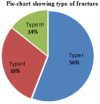Short-Term Management Outcomes of Supracondylar Fractures of the Humerus and Their Associated Factors in Children Managed at Mulago National Referral Hospital
- PMID: 35875360
- PMCID: PMC9297100
- DOI: 10.2147/ORR.S370357
Short-Term Management Outcomes of Supracondylar Fractures of the Humerus and Their Associated Factors in Children Managed at Mulago National Referral Hospital
Abstract
Purpose: Supracondylar fractures (SCF) of the humerus is one of the commonest global health concerns among children and need a rigorous management process to obtain satisfactory outcomes. It is of paramount importance to use systematic guidelines to aid abate bad fracture outcomes. The study primarily sought to determine the functional and radiological management outcomes of SCF of the humerus in children at Mulago National Referral Hospital (MNRH) and associated factors to the outcomes.
Methods: We conducted a hospital-based, cross-sectional study among children managed for SCF of the humerus at MNRH. Using Flynn's criteria, current flexion and extension at the elbow joints, humeroulnar angle and the neurology were assessed and compared to the contralateral limb to get the functional outcomes. The pre-management digital radiographs of the elbow joint were compared with the current radiographs to assess radiological outcomes. Bivariate and multivariate analyses were used to determine the associated factors.
Results: Of the 77 children, 46 (60%) were male with a mean age of 7.86±2.30 years. Gartland type I fracture constituted 55.8% (43), type II was 29.9% (23) and type III was 14.3% (11). About 88.3% of the patients were managed non-operatively and 11.7% were managed operatively. The overall satisfactory functional outcome was 46.7%, while 81.8% of the patients had a satisfactory radiological outcome at 6 months after the intervention. Delay in seeking treatment, type 1 fracture, and prolonged duration of immobilization were significantly associated with unsatisfactory functional management outcome. Type II fracture and prolonged duration of immobilization were significantly associated with unsatisfactory radiological management of SCF of the humerus.
Conclusion: The short-term functional outcome was unsatisfactory, while a satisfactory radiological outcome was found in most of the patients. Duration of immobilization, type of fracture, and seeking late medical care had a negative impact on the outcome of these fractures.
Keywords: children; fracture; management; outcome; supracondylar.
© 2022 Sheikdon et al.
Conflict of interest statement
The authors report no conflicts of interest in this work.
Figures




Similar articles
-
Outcomes of Gartland type III supracondylar fractures treated using Blount's method.Orthop Traumatol Surg Res. 2017 Nov;103(7):1121-1125. doi: 10.1016/j.otsr.2017.06.011. Epub 2017 Aug 3. Orthop Traumatol Surg Res. 2017. PMID: 28780003
-
Surgical management of Gartland type III supracondylar humerus fractures in older children: a retrospective study.J Pediatr Orthop B. 2019 Nov;28(6):530-535. doi: 10.1097/BPB.0000000000000582. J Pediatr Orthop B. 2019. PMID: 31568219 Free PMC article.
-
[Ultrasound-guided reduction and percutaneous crossed pin fixation for the treatment of displaced supracondylar fracture of the humerus in children].Zhongguo Gu Shang. 2020 Oct 25;33(10):907-11. doi: 10.12200/j.issn.1003-0034.2020.10.004. Zhongguo Gu Shang. 2020. PMID: 33107251 Chinese.
-
Supracondylar Humerus Fractures: Classification Based Treatment Algorithms.Indian J Orthop. 2020 Oct 22;55(1):68-80. doi: 10.1007/s43465-020-00285-2. eCollection 2021 Feb. Indian J Orthop. 2020. PMID: 33569100 Free PMC article. Review.
-
Management of Gartland Type 1 Supracondylar Fractures: A Systematic Review.Front Pediatr. 2022 May 19;10:863985. doi: 10.3389/fped.2022.863985. eCollection 2022. Front Pediatr. 2022. PMID: 35664877 Free PMC article.
References
-
- de Neira ZS, Prada-Cañizares A, Marti-Ciruelos R, Pretell-Mazzini J. Supracondylar humeral fractures in children: current concepts for management and prognosis. Int Orthop. 2015;39(11):2287–2296. - PubMed
-
- Omid R, Choi PD, Skaggs DL. Supracondylar humeral fractures in children. JBJS. 2008;90(5):1121–1132. - PubMed
-
- Zamzam MM, Bakarman KA. Treatment of displaced supracondylar humeral fractures among children: crossed versus lateral pinning. Injury. 2009;40(6):625–630. - PubMed
LinkOut - more resources
Full Text Sources
Research Materials

